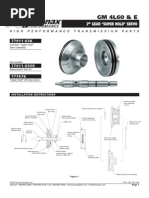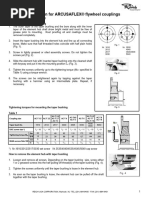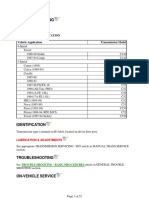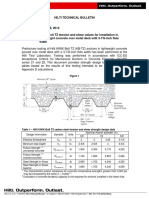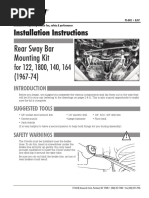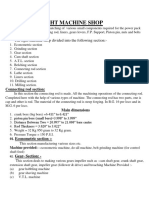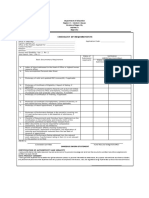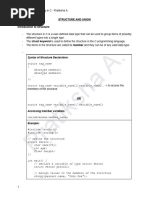SL Manual Lock 13 58 SHAFFER RAM BOP Page-26-30
SL Manual Lock 13 58 SHAFFER RAM BOP Page-26-30
Uploaded by
Richard EVCopyright:
Available Formats
SL Manual Lock 13 58 SHAFFER RAM BOP Page-26-30
SL Manual Lock 13 58 SHAFFER RAM BOP Page-26-30
Uploaded by
Richard EVOriginal Description:
Copyright
Available Formats
Share this document
Did you find this document useful?
Is this content inappropriate?
Copyright:
Available Formats
SL Manual Lock 13 58 SHAFFER RAM BOP Page-26-30
SL Manual Lock 13 58 SHAFFER RAM BOP Page-26-30
Uploaded by
Richard EVCopyright:
Available Formats
Section 3
Maintenance
3 . 1 2 . 2 Cleaning and Inspection of Rams 4. Remove the two ram rubber retaining screws as
shown in Figure 3-9. See Table 3-3 for the cor-
1. Clean the rams (see Appendix A). rect wrench size.
2. Inspect the ram rubbers for damage such as crack- 5. Remove the rubber from around the back side of
ing, gouging, chunking, or splitting. Replace the the block as shown in Figure 3-10. Remove this
rubbers, if damaged (see Section 3.13). rubber from both sides of the ram block.
3 . 1 2 . 3 Installation of Rams 6. Insert a punch into the rubber retaining screw
holes and drive the rubber out of the ram
1. Thoroughly grease all ram exterior surfaces and
block as shown in Figure 3-11. The punch
the ram shaft mounting slot.
must be smaller than the retaining screws to
2. Grease the inside of the BOP body at the follow- prevent damage to the threads.
ing locations: Note
• the ram shaft mounting head (see Figure 3-2) Check the retaining screw holes in
• the side pads in the body cavity the new rubber. Clean out any rub-
• the skids in the bottom of the body cavity ber which is in the hole itself. This
allows the retaining screws to freely
• the ram sealing seat in the top of the body cavity
engage the thread in the holes.
3. Apply thread lubricant specified in API 5A2 to
the door cap screws both on the threads and under 7. To install a new rubber, place the rubber
the heads. onto the block and drive it into position with
a rubber mallet.
4. Clean and oil the door face and replace the door
seal, if damaged (see Section 3.10 and Appendix 8. Pry the rubber onto the back side of the block
A). using a long screwdriver. Force the rubber
into position using a rubber mallet.
5. Clean and oil the door sealing surface on the body
(see Appendix A). 9. Install the ram block retracting screws and
torque them to the values given in Table 3-3.
Caution
Do not use grease on door faces or seal- 10. Place the ram holder into the block.
ing surfaces.
6. Mount the ram assembly on the ram shaft (see
Figure 3-7).
7. Close the door and make up the door cap screws
to 6,600 ft-lb (8,943 n-m) torque.
3 . 1 3 Changing Pipe and Blind Ram Rubbers
The pipe and blind ram rubbers are changed according to
the steps listed below.
1. Clean the ram (see Appendix A).
2. Remove the two ram block retracting screws as
shown in Figure 3-8. See Table 3-2 for the cor-
rect wrench size.
3. Remove the ram holder by sliding it away from
the block.
Figure 3-8
Removing the Ram Block Retracting Screws
3-8 October, 1994
Section 3
Maintenance
Table 3-2
SL Ram Block Retracting Screw Data
Working Wrench Size
Pressure Size Pipe Size Retracting Torque Across Flats
psi (bar) in. (mm) in. Screw P/N Thread ft-lb (N-m) in.
15,000 (1034) 135/8" (346) CSO–75/8" 142184 3"-8UN-2A 400–800 (542–1,084) 29/16" Socket
8 5/8"–103/4" 116190
11 (279) CSO–85/8" 142184
10,000 (690) 211/4" (540) CSO–181/8" 142184 17/8"-8UN-2A 200–400 (271–542) 7
/8" Hex Key
183/4" (176) CSO–16" 142184
163/4" (425) CSO–135/8" 142184
135/8" (346) CSO–103/4" 142061
11 (279) CSO–7 142061
7 5/8 "–8 5/8 " 142065
7 1 / 16 CSO–51/2 115577
3
5,000 (345) 16 /4" (425) CSO–135/8" 141200 11/8"-8UN-2A 100–150 (135–203) 13/4" Socket
135/8" (346) CSO–103/4" 141200
3,000 (207) 135/8" (346) CSO–103/4" 141200 11/8"-8UN-2A 100–150 (135–203) 13/4" Socket
Table 3-3
SL Ram Block Retaining Screw Data
Working Wrench Size
Pressure Size Pipe Size Retracting Torque Across Flats
psi (bar) in. (mm) in. Screw P/N Thread ft-lb (N-m) in.
15,000 (1034) 135/8" (346) CSO–103/4" 135160 1
/2"–8UN-2A 100–125(137–170) 3
/8" Socket
11 (279) CSO–85/8" 135160
10,000 (690) 211/4" (540) CSO–181/8" 135160 1
/2"–8UN-2A 100–125(137–170) 3
/8" Socket
183/4" (176) CSO–16" 135160
163/4" (425) CSO–135/8" 135160
135/8" (346) CSO–103/4" 135546
11 (279) CSO–85/8" 135546
5,000 (345) 163/4" (425) CSO–135/8" 135160 1
/2"–8UN-2A 100–125(137–170) 3
/8" Socket
135/8" (346) CSO-103/4" 135546
3,000 (207) 135/8" (346) CSO–103/4" 135546 1
/2"–8UN-2A 100–125(137–170) 3
/8" Socket
Figure 3-9 Figure 3-11
Removing the Ram Rubber Retaining Screws Driving the Ram Rubber out of the Block
October, 1994 3-9
Section 3
Maintenance
Figure 3-10
Removing the Ram Rubber
11. Install the ram block retracting screws and torque
them to the values given in Table 3-2.
Note
The gap between the rubber and the
block should be 1/ 16" (1.57 mm) (see Block
Figure 3-12). Holder
Rubber
1
/ 16" Gap
Caution
Figure 3-12
Do not use an air-impact wrench to in- 1
/ 16" Gap Between the Rubber and Holder
stall the ram block retracting screws and
do not exceed the recommended torques
given in Table 3-2. Excessive torque on 3. Install the ram block in a vertical position and
the retracting screws will damage the use a punch to drive the top seal retainer pins
shoulders and cause them to run-in too out (see Figure 3-14). Remove the top seal as
far. This will cause the holder to squeeze shown in Figure 3-15.
the rubber against the block and dam-
age the rubber when the rams are closed. 4. Using a screwdriver, pry the face seal out of the
ram block (see Figure 3-16).
Caution
5. For reinstalling the ram rubber, reverse this pro-
The shoulder on the retracting screw
cedure.
allows the screw to stop at a point
which allows the holder to float. Do
not install washers or shims. If the 3 . 1 5 Cleaning and Storage of the SL BOP
holder is snugged down too tightly A BOP should be cleaned immediately after it is taken out of
the rams will not hold wellbore service. Proper cleaning of a BOP before it is stored will
pressure. increase its life significantly. If a BOP is in an active drilling
program, this cleaning should be done approximately every
three months or when the rig is between wells.
3.14 Changing Multi-Ram Rubbers
1. Open the doors and remove the rams (see Sec-
1. Clean the ram (see Appendix A). tion 3.12.1).
2. Remove retainer screw (see Figure 3-13).
3-10 October, 1994
Section 3
Maintenance
Figure 3-13
Remove Retainer Screw Figure 3-15
Remove Top Seal
Figure 3-14 Figure 3-16
Punch Out Top Seal Retainer Pins Remove Face Seal
Caution 7. Close and open the rams several times with clean
hydraulic oil. This will flush any water out of
If the BOP is not flanged to a wellhead
the cylinders and prevent rusting while the BOP
or securely fastened, open only one door
is stored. After disconnecting the opening and
at a time. The weight of two open doors
closing hydraulic lines, insert pipe plugs in the
can tip the BOP over.
hydraulic ports and leave oil inside the cylinders.
Store the BOP with the rams removed and the
2. Wash the inside and outside of the BOP, Remove piston in the open position. This will keep the
all caked mud and cement (see Appendix A). ram shafts in the oil and protect them from ac-
cidental damage.
3. Thoroughly grease all inside surfaces of the BOP.
Fill the ring grooves with grease (see Appendix 8. Paint the outside of the BOP to prevent it from
A). rusting. The grease in the ring grooves will keep
the paint out of the ring grooves and they will be
4. Oil the inside face of the doors and the door seal- ready for the next installation.
ing surfaces on the body.
9. Remove the retracting screws and holders (see
5. Apply thread lubricant API 5A2 to: Section 3.13). Leave the rubbers on the blocks if
• the door bolt threads they are to be reused.
• under the heads of the door bolts 10. Grease the blocks and holders. Be sure to grease
the ID of the holders (see Appendix A).
6. Close the doors and tighten the door bolts. For
storage, they should be snug but not fully torqued.
October, 1994 3-11
Section 3
Maintenance
11. Apply thread lubricant API 5A2 to the retract- Both natural and synthetic rubber parts are susceptible to
ing screw threads and to the body of the screws. deterioration from various solvents, e.g. oil field liquid hy-
drocarbon, which causes swelling or shrinkage.
12. Reinstall the holders and retracting screws on the In the final analysis, personal judgement determines whether
blocks. a rubber part should be used. If there is doubt, replace the
Caution part.
• Rubber parts should be stored as described
Do not use an air impact wrench to in- below.
stall the ram block retracting screws and
do not exceed the recommended torques 3 Store rubber parts in a dark place,
given in Table 3-2. Excessive torque on indoors, and away from sunlight,
the retracting screws will damage the windows, and direct artificial lighting.
shoulders and cause them to run in too 3 Store in a cool location [approximately 65
far. This will cause the holder to squeeze °F (18 ½C)].
the rubber against the block, damaging 3 Store rubber parts in their natural shape.
the rubber when the rams are closed. Do not hang O-rings on nails or hooks.
3 Storage areas should be kept as dry as
13. Store the rams outside the BOP. possible. Oil, grease, or other fluids
should be stored elsewhere to avoid
14. BOPs and rams should be stored indoors or at spillage.
least under a shed to keep the sun and rain off
3 If storage is for a long duration, it is
them.
recommended that rubber parts be placed
in sealed containers or be given a
3 . 1 6 Storage and Inspection of Rubber Parts protective surface covering impervious
Shaffer rubber parts are especially compounded to give to temperature or light. This will extend
maximum storage life under normal oilfield conditions. the shelf life.
Proper storage minimizes deterioration and increases 3 Rubber parts should be used on a first
the service life of these items. in, first out basis.
Aging of rubber parts is based on several factors, in- • Inspect rubber parts as described below.
cluding atmosphere, light, temperature, and size. Ozone
3 Each rubber part must be inspected before
in the atmosphere reacts with rubber parts and hastens
it is put into service.
deterioration. Rubber parts should never be stored around
electrical equipment because of the occurrence of ozone. 3 Bend, stretch, or compress each part and
look for cracks.
Direct light, especially sunlight which contains ultra-
violet rays, is very harmful and must be avoided. Note
All rubber parts undergo several kinds of changes when Some cracks are not obvious, but
they are exposed to low temperature. In temperatures when the rubber part is bent,
of –40 °F (–40 °C) the rubber becomes brittle and will shat- stretched, or compressed, very minute
ter when dropped or handled roughly. Some changes occur cracks will become apparent.
immediately, others after prolonged exposure. All are re-
versible; the rubber regains its original properties when it is 3 Observe if the rubber part has a hard
returned to 65 °F (18 °C) or room temperature. skin or small cracks which may become
Heat causes a gradual hardening of the rubber, especially chalky or barklike in appearance.
when ozone or oxygen is present. In warm, humid climates,
particularly the tropics, fungi and bacteria attack the or- 3.17 Troubleshooting
ganic content in reinforced rubber parts. The troubleshooting table (Table 3-4) provides possible causes
The size, composition, and function of rubber parts prevents and corrective action for some of the more common prob-
giving a precise shelf life. Large rubber parts might suffer lems likely to be encountered.
the same amount of deterioration as small parts and still be
usable, whereas small parts become useless and should be
thrown away.
3-12 October, 1994
You might also like
- Full ManualDocument13 pagesFull ManualSteve Dowell83% (6)
- XQ89 3YC英文说明书Document25 pagesXQ89 3YC英文说明书ADM MTC100% (1)
- Tabulation of NBCP, BP344, FirecodeDocument10 pagesTabulation of NBCP, BP344, FirecodeannaNo ratings yet
- Hydratight PDFDocument40 pagesHydratight PDFTamer Farahat100% (1)
- Case Study WritingDocument3 pagesCase Study Writingahmad_chatha00100% (1)
- SRAM SPECTRO S7 Maintenance - en PDFDocument0 pagesSRAM SPECTRO S7 Maintenance - en PDFkuvalda2000No ratings yet
- Weir Minerals Multiflo Electro-Magnetic (Robatic) Clutch Disassembly AND Assembly ProcedureDocument10 pagesWeir Minerals Multiflo Electro-Magnetic (Robatic) Clutch Disassembly AND Assembly ProcedurePutra JawaNo ratings yet
- AlemiteDocument10 pagesAlemiteGer DclNo ratings yet
- FRAME RIVETS REPLACEMENT WITH BOLTS SERVICE TIPS - Article No. 97-4-7Document2 pagesFRAME RIVETS REPLACEMENT WITH BOLTS SERVICE TIPS - Article No. 97-4-7FlogamagNo ratings yet
- Procedures For Rotational Capacity Testing of Galvanized ASTM A325 ..Document14 pagesProcedures For Rotational Capacity Testing of Galvanized ASTM A325 ..Sayed Diab AlsayedNo ratings yet
- Sturmey Archer S RF3 Hub InstructionsDocument4 pagesSturmey Archer S RF3 Hub Instructionsdupazbita11No ratings yet
- Sturmey-Archer SRF3 User ManualDocument4 pagesSturmey-Archer SRF3 User Manualksjack100% (1)
- REHS4184-00 Procedure For Inspecting and Replacing The Cartridge Assemblies On 992G, 992K, 993K LoadersDocument5 pagesREHS4184-00 Procedure For Inspecting and Replacing The Cartridge Assemblies On 992G, 992K, 993K Loaderszawmoe aungNo ratings yet
- FT1390-2-9-500 Crimp MachineDocument8 pagesFT1390-2-9-500 Crimp MachineJulián Ricardo RodriguezNo ratings yet
- 4l60 TrannyDocument4 pages4l60 Trannyridler16No ratings yet
- Wadkin BER 2 Spindle Moulder Manual & Parts ListDocument18 pagesWadkin BER 2 Spindle Moulder Manual & Parts Listmkmk15793No ratings yet
- Meritor Spindle NutDocument5 pagesMeritor Spindle NutPhrag MannsteinNo ratings yet
- Cee-2027 AntirollDocument6 pagesCee-2027 Antirollalexi calatayudNo ratings yet
- 2012 Fork Service ManualDocument36 pages2012 Fork Service ManualFer SabidongNo ratings yet
- Propeller Shaft PDFDocument11 pagesPropeller Shaft PDFAndrey Gladyshev100% (1)
- Rexnord Elastomer CouplingDocument20 pagesRexnord Elastomer Couplingidontlikeebooks100% (1)
- Classic 60 Deck Service Kit 902415Document3 pagesClassic 60 Deck Service Kit 902415pwoody571No ratings yet
- Procedures For Rotational Capacity Testing For High Strength BoltsDocument12 pagesProcedures For Rotational Capacity Testing For High Strength BoltsAGnes Stephani MuntheNo ratings yet
- Asae s278.6 Enganche Rapido Modificado 7Document4 pagesAsae s278.6 Enganche Rapido Modificado 7Policarpio Mamani HuchaniNo ratings yet
- Luz de Valvulas e Inyectores Serie 60Document6 pagesLuz de Valvulas e Inyectores Serie 60Kelvin Ramirez75% (4)
- DisassemblyDocument8 pagesDisassemblyEdson CRNo ratings yet
- Taper Grip Installation GuideDocument2 pagesTaper Grip Installation GuideFredy Jesus Quispe ValverdeNo ratings yet
- Medidas Do Motor 01Document3 pagesMedidas Do Motor 01Nelson ConselhoNo ratings yet
- Sect 09 Multi-Stage FracturingDocument8 pagesSect 09 Multi-Stage FracturingpaimanNo ratings yet
- Hose ClampsDocument3 pagesHose ClampsDesalegn AbateNo ratings yet
- Service Guide: Low-Pressure Stub PumpDocument10 pagesService Guide: Low-Pressure Stub PumpMauricio Ariel H. OrellanaNo ratings yet
- Normas ChavetasDocument5 pagesNormas ChavetasjofeluNo ratings yet
- AC Installation Instructions Rev BDocument3 pagesAC Installation Instructions Rev BLazaros KarapouNo ratings yet
- Caterpillar Cat D7R II TRACK-TYPE TRACTOR (Prefix BNX) Service Repair Manual Instant DownloadDocument35 pagesCaterpillar Cat D7R II TRACK-TYPE TRACTOR (Prefix BNX) Service Repair Manual Instant Downloadaemil2711No ratings yet
- Removal/installation Recommendations: Identification of NTN-SNR Wheel Bearing KIT R140.77Document7 pagesRemoval/installation Recommendations: Identification of NTN-SNR Wheel Bearing KIT R140.77Ioan PascaNo ratings yet
- FL6003 PDFDocument4 pagesFL6003 PDFMauricio Barrios CastellanosNo ratings yet
- Overhaul 4 & 5 SpeedDocument22 pagesOverhaul 4 & 5 SpeedJeff PascoeNo ratings yet
- 50 Steering ColumnDocument32 pages50 Steering ColumnTung NguyenNo ratings yet
- Manual TransmissionDocument46 pagesManual Transmissionjrrodrigueza2No ratings yet
- Moldboard Wear Strip - Inspect Adjust ReplaceDocument3 pagesMoldboard Wear Strip - Inspect Adjust ReplaceNasrul arulNo ratings yet
- Propeller ShaftDocument17 pagesPropeller ShaftdwcdiscoNo ratings yet
- Ford Installation InstructionDocument14 pagesFord Installation Instructiontxr qcNo ratings yet
- AE1219Document4 pagesAE1219Maria DazaNo ratings yet
- f100 Front SystemDocument13 pagesf100 Front SystemAndrei100% (1)
- Technical Bulletin For Kwik BoltDocument3 pagesTechnical Bulletin For Kwik BoltAbu Hena Mostofa KamalNo ratings yet
- Manual PDFDocument70 pagesManual PDFUsama Popatia100% (1)
- HRC Couplings: Maryland MetricsDocument8 pagesHRC Couplings: Maryland MetricsnguyenhuanNo ratings yet
- Hfe Denon Avr-1403 1603 1803 Service Info Ost-760 enDocument3 pagesHfe Denon Avr-1403 1603 1803 Service Info Ost-760 enewidanceNo ratings yet
- C.rod 2Document3 pagesC.rod 2Eka Sukanda ZaeniNo ratings yet
- Rear Sway Bar Installation InstructionsDocument4 pagesRear Sway Bar Installation InstructionsRaduNo ratings yet
- Ss185re Snorkel Toyota InstallDocument7 pagesSs185re Snorkel Toyota InstallFrancisco BeloucheNo ratings yet
- SEBF 8174 коромысла 3500Document13 pagesSEBF 8174 коромысла 3500Евгений АбрамовNo ratings yet
- Spicer Flange Yokes - J300-P2Document16 pagesSpicer Flange Yokes - J300-P2PrasadNo ratings yet
- MOUNTING AND ALLIGNMENT PROCEDURE FOR Z Print 2Document9 pagesMOUNTING AND ALLIGNMENT PROCEDURE FOR Z Print 2SaniNo ratings yet
- CM50 Series Main TransmissionDocument55 pagesCM50 Series Main TransmissionDanyer CmNo ratings yet
- Service Manual: VCR Mechanism UnitDocument34 pagesService Manual: VCR Mechanism UnitcobrabrNo ratings yet
- The Light Machine Shop Divided Into The Following SectionDocument5 pagesThe Light Machine Shop Divided Into The Following Sectionyogendra singhNo ratings yet
- Plymouth and Chrysler-built cars Complete Owner's Handbook of Repair and MaintenanceFrom EverandPlymouth and Chrysler-built cars Complete Owner's Handbook of Repair and MaintenanceNo ratings yet
- How to Build a Children's Swing, Slide, Roundabout and Toboggan for the Garden - An Illustrated GuideFrom EverandHow to Build a Children's Swing, Slide, Roundabout and Toboggan for the Garden - An Illustrated GuideNo ratings yet
- SL Manual Lock 13 58 SHAFFER RAM BOP Page-36-40Document5 pagesSL Manual Lock 13 58 SHAFFER RAM BOP Page-36-40Richard EVNo ratings yet
- SL Manual Lock 13 58 SHAFFER RAM BOP Page-1-5Document5 pagesSL Manual Lock 13 58 SHAFFER RAM BOP Page-1-5Richard EVNo ratings yet
- SL Manual Lock 13 58 SHAFFER RAM BOP Page-16-20Document5 pagesSL Manual Lock 13 58 SHAFFER RAM BOP Page-16-20Richard EV100% (1)
- SL Manual Lock 13 58 SHAFFER RAM BOP Page-21-25Document5 pagesSL Manual Lock 13 58 SHAFFER RAM BOP Page-21-25Richard EVNo ratings yet
- SL Manual Lock 13 58 Shaffer Ram Bop Page-11-15Document5 pagesSL Manual Lock 13 58 Shaffer Ram Bop Page-11-15Richard EVNo ratings yet
- SL Manual Lock 13 58 SHAFFER RAM BOP Page-6-10Document5 pagesSL Manual Lock 13 58 SHAFFER RAM BOP Page-6-10Richard EVNo ratings yet
- Battery and Vessel - : For Compressor Without Cold Weather Equipments EC StandardDocument2 pagesBattery and Vessel - : For Compressor Without Cold Weather Equipments EC StandardRichard EVNo ratings yet
- XA Series 62Document1 pageXA Series 62Richard EVNo ratings yet
- XA Series 58 59Document2 pagesXA Series 58 59Richard EVNo ratings yet
- Frame and Mounts - : StandardDocument1 pageFrame and Mounts - : StandardRichard EVNo ratings yet
- JDN Air Hoists ProfiDocument8 pagesJDN Air Hoists ProfiRichard EVNo ratings yet
- Oil System - : StandardDocument2 pagesOil System - : StandardRichard EVNo ratings yet
- Aramax Wedge-Band: Banded BeltDocument4 pagesAramax Wedge-Band: Banded BeltRichard EVNo ratings yet
- Bodywork - : XAS 137 StandardDocument4 pagesBodywork - : XAS 137 StandardRichard EVNo ratings yet
- T 19Document1 pageT 19Richard EVNo ratings yet
- G-SHOCK Manual 5132 PDFDocument4 pagesG-SHOCK Manual 5132 PDFRichard EV100% (1)
- Bourdon Tube Pressure Gauges Stainless Steel, Safety Pattern Version, High Overpressure Safety Model 232.36/233.36, Without/with Liquid FillingDocument2 pagesBourdon Tube Pressure Gauges Stainless Steel, Safety Pattern Version, High Overpressure Safety Model 232.36/233.36, Without/with Liquid FillingRichard EVNo ratings yet
- Yoke Industrial Corp.: Company Profi LeDocument1 pageYoke Industrial Corp.: Company Profi LeRichard EVNo ratings yet
- Fishing Tools PDFDocument45 pagesFishing Tools PDFRichard EV100% (1)
- Ks Permaglide CatalogueDocument76 pagesKs Permaglide CatalogueSkocko SkockicNo ratings yet
- Pacseal HydraulicDocument10 pagesPacseal HydraulicRichard EVNo ratings yet
- Rig Power LLCDocument12 pagesRig Power LLCRichard EVNo ratings yet
- Quincy CompressorDocument112 pagesQuincy CompressorRichard EV100% (2)
- Agitator Manual AM 001 Rev5Document37 pagesAgitator Manual AM 001 Rev5Richard EVNo ratings yet
- Bourdon Tube Pressure Gauges Stainless Steel, Safety Pattern Version, High Overpressure Safety Model 232.36/233.36, Without/with Liquid FillingDocument2 pagesBourdon Tube Pressure Gauges Stainless Steel, Safety Pattern Version, High Overpressure Safety Model 232.36/233.36, Without/with Liquid FillingRichard EVNo ratings yet
- MAYAKIINC BusinessPlanDocument20 pagesMAYAKIINC BusinessPlanRichard EVNo ratings yet
- Thompson and Mishra 2007Document3 pagesThompson and Mishra 2007Hatice MaNo ratings yet
- Alcatel Lucent Omniswitch 6465 Hardware Guide Rev NDocument97 pagesAlcatel Lucent Omniswitch 6465 Hardware Guide Rev NdilnuwanNo ratings yet
- Cyber Forensics MCQDocument12 pagesCyber Forensics MCQGingerNo ratings yet
- Mechanical Properties of Dental Composite Materials Reinforced With Micro and Nano-Size Al O Filler ParticlesDocument9 pagesMechanical Properties of Dental Composite Materials Reinforced With Micro and Nano-Size Al O Filler ParticlesThanh Thao TranNo ratings yet
- PT AWS ProjectDocument17 pagesPT AWS ProjectPhil ThibodeauNo ratings yet
- GCP CURSO 2 03-Virtual-MachinesDocument63 pagesGCP CURSO 2 03-Virtual-MachinesMartin CalvoNo ratings yet
- Megadyne Mega Power Electrosurgical Generator Quick Start GuideDocument2 pagesMegadyne Mega Power Electrosurgical Generator Quick Start GuideHeidi BlueNo ratings yet
- LCD Video Wall Installation Manual (En)Document53 pagesLCD Video Wall Installation Manual (En)dan boysilloNo ratings yet
- InverterDocument11 pagesInverterchedni yahiaNo ratings yet
- Nerolac Excel-Anti Peel 1Document2 pagesNerolac Excel-Anti Peel 1Mahend RanNo ratings yet
- Ensayos Del Gran GatsbyDocument5 pagesEnsayos Del Gran Gatsbylolupyniwog2100% (2)
- Microchip - 8bit - Voltmeter at Master Xpress-Embedo - Microchip - 8bit GitHubDocument6 pagesMicrochip - 8bit - Voltmeter at Master Xpress-Embedo - Microchip - 8bit GitHubTaramba kossiNo ratings yet
- DRS3 3.4.0.0, Guidance On Reporting ProceduresDocument18 pagesDRS3 3.4.0.0, Guidance On Reporting ProceduresAvick TribediNo ratings yet
- Class 1: Pttep International Limited (Myanmar) Zawtika Development ProjectDocument10 pagesClass 1: Pttep International Limited (Myanmar) Zawtika Development ProjectfajarNo ratings yet
- Checklist T1 PositionDocument2 pagesChecklist T1 PositionEroll NallosNo ratings yet
- G10 DLL TPSDocument6 pagesG10 DLL TPSAMHERSTYA DJOANNA DIAZNo ratings yet
- OpenBMCDocument40 pagesOpenBMCmyTertNo ratings yet
- Bitcoin ATM Machine in Belfast at Castle Court SHDocument1 pageBitcoin ATM Machine in Belfast at Castle Court SHlongmarshall08No ratings yet
- RatedPower Pvdesign How To Create A DesignDocument94 pagesRatedPower Pvdesign How To Create A DesignDavid López100% (1)
- Final Report On The Key Comparison Ccm.P-K4.2012 in Absolute Pressure From 1 Pa To 10 KpaDocument37 pagesFinal Report On The Key Comparison Ccm.P-K4.2012 in Absolute Pressure From 1 Pa To 10 KpaMaria Isabel LadinoNo ratings yet
- Sadeghi Et Al. - 2023Document18 pagesSadeghi Et Al. - 2023apatzNo ratings yet
- Safety FormatsDocument37 pagesSafety FormatsRanjan Kumar PrustyNo ratings yet
- ENOX Price List PDFDocument56 pagesENOX Price List PDFSuneel Sharma100% (2)
- SHARE 16131 FlashCopy DB2 Online Utils PDFDocument45 pagesSHARE 16131 FlashCopy DB2 Online Utils PDFBui Hoang GiangNo ratings yet
- Music Assistants Sop 1-6-2022Document13 pagesMusic Assistants Sop 1-6-2022John NorineNo ratings yet
- MODEL NO.: V500HK1 Suffix: Ps1: 50.0" FHD - 60Hz - Open Cell Source Board+Control Board+FFC CableDocument35 pagesMODEL NO.: V500HK1 Suffix: Ps1: 50.0" FHD - 60Hz - Open Cell Source Board+Control Board+FFC CableJridette WalidNo ratings yet
- Electromagnetic Water Flow MeterDocument9 pagesElectromagnetic Water Flow Meterrajesh kothariNo ratings yet
- CPC - Module - 5Document5 pagesCPC - Module - 5Mahi GawdeNo ratings yet















